Indonesian cuisine/ja: Difference between revisions
| Line 198: | Line 198: | ||
インドネシアの一般的な料理のほとんどは、主要な材料と調理法にちなんで名付けられている。例えば、「[[ayam goreng/ja|アヤム・ゴレン]]」は「ayam」(鶏肉)と「goreng」(揚げる)から成り、[[fried chicken/ja|フライドチキン]]を意味する。「[[Mie goreng/ja|ミー・ゴレン]]」は焼きそば、「[[ikan bakar/ja|イカン・バカール]]」は焼き魚、「udang rebus」は茹でエビ、「[[babi panggang/ja|バビ・パンガン]]」はローストポーク、「tumis kangkung」は[[water spinach/ja|空芯菜]]の炒め物である。インドネシアの台所での調理法は、「goreng」([[frying/ja|揚げる]])は少量の油で揚げるか、多量の食用油で[[deep frying|揚げる]]か、「tumis」([[stir frying/ja|炒める]])、「sangrai」([[sautéing/ja|ソテーする]])である。焙煎法は「bakar」([[grilling/ja|グリルする]])で、通常[[charcoal/ja|木炭]]、[[firewood/ja|薪]]、またはココナッツの殻を使用し、「panggang」([[baking/ja|焼く]]/[[roasting/ja|ローストする]])は通常[[oven/ja|オーブン]]を使用するものを指す。その他の方法としては、「rebus」([[boiling/ja|茹でる]])、「kukus」([[steaming/ja|蒸す]])、「asap」/「salai」([[smoking (cooking)/ja|燻製する]])がある。 | インドネシアの一般的な料理のほとんどは、主要な材料と調理法にちなんで名付けられている。例えば、「[[ayam goreng/ja|アヤム・ゴレン]]」は「ayam」(鶏肉)と「goreng」(揚げる)から成り、[[fried chicken/ja|フライドチキン]]を意味する。「[[Mie goreng/ja|ミー・ゴレン]]」は焼きそば、「[[ikan bakar/ja|イカン・バカール]]」は焼き魚、「udang rebus」は茹でエビ、「[[babi panggang/ja|バビ・パンガン]]」はローストポーク、「tumis kangkung」は[[water spinach/ja|空芯菜]]の炒め物である。インドネシアの台所での調理法は、「goreng」([[frying/ja|揚げる]])は少量の油で揚げるか、多量の食用油で[[deep frying|揚げる]]か、「tumis」([[stir frying/ja|炒める]])、「sangrai」([[sautéing/ja|ソテーする]])である。焙煎法は「bakar」([[grilling/ja|グリルする]])で、通常[[charcoal/ja|木炭]]、[[firewood/ja|薪]]、またはココナッツの殻を使用し、「panggang」([[baking/ja|焼く]]/[[roasting/ja|ローストする]])は通常[[oven/ja|オーブン]]を使用するものを指す。その他の方法としては、「rebus」([[boiling/ja|茹でる]])、「kukus」([[steaming/ja|蒸す]])、「asap」/「salai」([[smoking (cooking)/ja|燻製する]])がある。 | ||
調理に使う火は、強火でも弱火でも、ゆっくり煮込むことができる。[[nasi goreng/ja|ナシゴレン]]の調理には通常強火を使うが、本格的な「[[rendang/ja|ルンダン]]」は、牛肉、スパイス、ココナッツミルクを肉がキャラメル化し、ココナッツミルクの水分がすべて蒸発するまでゆっくり煮込むために弱火が必要である。伝統的なインドネシアの「dapur」([[kitchen/ja|台所]])は通常、薪を燃料とする[[kitchen stove/ja|かまど]]を使用するが、現代の家庭では[[:en:liquefied petroleum gas|液化石油ガス]]を燃料とするストーブや電気ストーブを使用している。材料は細かく切ったり、薄切りにしたり、ペースト状に挽いたりする。調理器具は「wajan」([[wok/ja|中華鍋]])、「penggorengan」([[frying pan/ja|フライパン]])、「panci」([[cauldron/ja|大鍋]])、[[knife/ja|包丁]]、数種類の[[spoon/ja|スプーン]]と[[fork/ja|フォーク]]、「parutan」(おろし金)、「cobek」と「ulekan」(石製の[[mortar and pestle/ja|すり鉢とすりこぎ]])である。伝統的にインドネシア人は石製のすり鉢とすりこぎでスパイスや材料を粗いペーストや細かいペーストに挽いていた。今日ではほとんどの家庭でこの作業に[[blender/ja|ブレンダー]]や[[food processor/ja|フードプロセッサー]]を使用している。伝統的なインドネシアの調理器具は通常、石、[[earthenware/ja|土器]]、[[pottery/ja|陶器]]、木材、編み込んだ竹や籐の容器またはフィルターで作られていたが、現代の調理器具、皿、容器は金属(鉄、錫、ステンレス鋼、アルミニウム)、陶磁器、プラスチック、ガラスを使用している。 | |||
<div lang="en" dir="ltr" class="mw-content-ltr"> | <div lang="en" dir="ltr" class="mw-content-ltr"> | ||
Revision as of 08:49, 23 June 2025

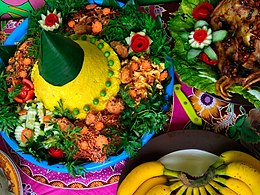 |
| この記事は下記のシリーズの一部です |
| インドネシア料理 Masakan Indonesia |
|---|
| Culture of Indonesia |
|---|
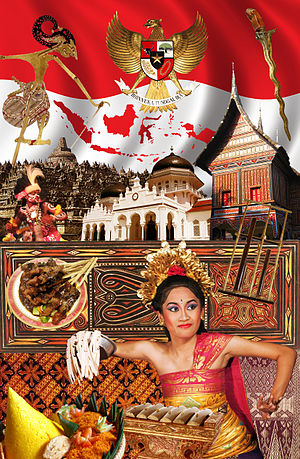 |
| Cuisine |
| performing arts |
インドネシア料理は、インドネシアという群島国家を形成する様々な民族集団による、多様な地域の料理の伝統を集めたものである。インドネシアは、世界最大の群島を構成する合計17,508の島のうち、約6,000の有人島と600以上の民族集団からなるため、非常に多種多様な調理法と料理が存在する。
多くの地域料理があり、しばしば先住民族の文化を基盤とし、いくつかの外来の影響を受けている。
伝統と特徴
インドネシアには約5,350の伝統的なレシピがあり、そのうち30が最も重要とされている。インドネシア料理は、質素な地元の飲食店で提供される米、麺、スープ料理から、路上で売られるスナックや高価な料理まで多岐にわたる。
インドネシア料理は地域によって大きく異なり、様々な影響を受けている。例えば、スマトラ料理は中東やインドの影響を強く受けており、グライやカレーのようなカレー風味の肉料理や野菜料理が特徴である一方、ジャワ料理はほとんどが土着のもので、中華料理の影響がわずかに見られる。
東インドネシアの料理は、ポリネシア料理やメラネシア料理に似ている。中華料理の要素はインドネシア料理にも見られ、麺、肉団子、春巻き、ワンタンなどの食品は完全に同化している。
インドネシアは歴史を通じて、その立地と天然資源のために貿易に関わってきた。さらに、インドネシアの土着の技術と食材は、インド、中東、中国、そして最終的にヨーロッパの影響を受けた。スペインやポルトガルの商人たちは、オランダが群島の大部分を植民地化する以前から新世界の産物をもたらした。モルッカ諸島(マルク州)として知られるインドネシアの島々は「スパイス諸島」として有名であり、クローブやナツメグといった固有のスパイスをインドネシア料理や世界中の料理にもたらすのに貢献した。
インドネシア料理はしばしば、特定の食材と「ブンブ」(スパイスの混合物)から得られる複雑な風味を示す。インドネシア料理は豊かな風味を持ち、ほとんどの場合、うま味、辛味、そして甘味、塩味、酸味、苦味といった基本的な味の組み合わせとして表現される。ほとんどのインドネシア人は辛い食べ物を好むため、エビペースト、エシャロットなどの様々なオプションの材料が入ったインドネシアの辛いチリソースである「サンバル」は、すべてのインドネシアの食卓に欠かせない調味料である。インドネシアの7つの主要な調理方法は、揚げる、焼く、炙る、乾煎りする、炒める、煮る、蒸すである。

「ナシゴレン」、「ガドガド」、「サテ」といった人気のあるインドネシア料理は、国内で広く普及しており、国民食とされている。インドネシアの公式な国民食は「トゥンペン」であり、2014年にインドネシア観光創造経済省によって、インドネシアの多様な料理の伝統を結びつける料理として選ばれた。その後、2018年には同省がインドネシアの5つの国民食として、「ソト」、「ルンダン」、「サテ」、「ナシゴレン」、「ガドガド」を選定している。

現在、インドネシアを起源とする人気のある料理の中には、近隣国のマレーシアやシンガポールでも一般的になっているものがある。サテ、牛肉の「ルンダン」、「サンバル」といったインドネシア料理は、マレーシアやシンガポールで人気がある。豆腐やテンペのバリエーションといった大豆ベースの料理も非常に人気が高い。テンペはジャワの発明と見なされており、大豆をベースにした食品の発酵と生産の現地への適応である。もう一つの発酵食品は「オンチョム」で、テンペといくつかの点で似ているが、様々な基材(大豆だけでなく)を使用し、異なる菌類によって作られ、特に西ジャワで人気がある。
歴史

インドネシア料理には長い歴史がある。そのほとんどは十分に文書化されておらず、地域の慣習や口頭伝承に大きく依存している。稀な例としては、かなりよく文書化された料理の伝統を持つジャワ料理が挙げられる。その多様性は、インドネシア東部のパプア族によって実践されてきた古代の「バカール・バトゥ」(石で焼いたヤムイモやイノシシ)から、洗練された現代のインドネシアフュージョン料理まで多岐にわたる。インドネシアの諸島の民族的多様性は、地元のジャワ料理、スンダ料理、バリ料理、ミナン料理、マレー料理、その他の先住民の料理の伝統と、数世紀にわたるインドの商人、中国の移民、オランダの植民地との外国との接触を組み合わせた折衷的な組み合わせを提供している。

米はインドネシア社会にとって不可欠な主食であり、9世紀のボロブドゥールとプランバナンのレリーフには古代ジャワでの稲作が描かれている。古代の料理は多くのジャワの碑文に記されており、歴史家はそれらのいくつかを解読することに成功している。8世紀から10世紀頃のマタラム王国時代の碑文には、いくつかの古代料理が記されている。その中には、「hadaŋan haraŋ」(水牛のひき肉のサテで、今日のバリの「サテ・リリット」に似ている)、「hadaŋan madura」(甘いパームシュガーで煮込んだ水牛の肉)、そして「dundu puyengan」(レモンバジルで味付けしたウナギ)がある。また、「haraŋ-haraŋ」(グリルした肉)には、「celeṅ/wök」(豚肉)、「hadahan/kbo」(水牛)、「kidaŋ/knas」(鹿)、「wḍus」(ヤギ)などがある。古代の飲料には、「nalaka rasa」(サトウキビジュース)、「jati wangi」(ジャスミンドリンク)、「kinca」(タマリンドジュース)がある。また、様々な「クルバン」(スパイスで調理した茹で野菜で、今日の「ウラップ」に似ている)や「phalamula」(茹でたヤムイモや塊茎を液体のパームシュガーで提供するもの)がある。その他の古代の野菜料理には、「rumwah-rumwah」(「ララップ」)、「dudutan」(生野菜)、「tetis」がある。
9世紀の古ジャワのカカウィン・ラマヤナには、トリジャタがシータに食事を提供した際に調理技術について言及されている(canto 17.101)。「landuga tatla-tila」(油で調理したもの)と「modakanda sagula」(砂糖を使った菓子)という美味しい料理が提供された。
10世紀から15世紀にかけてのいくつかのジャワの碑文には、いくつかの食品が言及されている。これらの料理のいくつかは、現在のジャワの食品と同一視されている。その中には、「プチェル」、「ピンダン」、「rarawwan」(ラウォン)、「rurujak」(ルジャック)、「kurupuk」(クルプク)、菓子類では「wajik」や「dodol」、飲料では「dawet」がある。
15世紀のスンダの写本サンヒャン・シクサカンダ・ン・カレシアには、当時のスンダ料理の一般的な味として、「lawana」(塩辛い)、「kaduka」(辛い)、「tritka」(苦い)、「amba」(酸っぱい)、「kasaya」(香ばしい)、「madura」(甘い)が挙げられている。
13世紀から15世紀にかけて、沿岸部のインドネシアの政治勢力は、インドや中東からの料理の影響を吸収し始めた。これは、この地域でカレーに似たレシピが採用されたことから明らかである。これは特にアチェ、西スマトラのミナンカバウ地方、スマトラとマレー半島のマレーの港湾都市で顕著であった。その結果、これらの料理の伝統は、「kare」(カレー)、「roti cane」、「グライ」など、典型的なインド料理の影響を示している。これはまた、イスラム教の採用と並行して進み、豚肉を省く「ハラール」のイスラム教の食事規定を奨励した。一方で、バタック族やダヤク族など、内陸に住む先住民は、ブッシュミート、豚肉、血液を日常の食事に取り入れた、より古いオーストロネシアの料理の伝統を保持している。

17世紀のライクロフ・ファン・フーエンスの記録によると、VOCのスルタン・アグンのジャワマタラム宮廷への大使であった彼の記録では、ジャワでの祝祭における肉(羊、ヤギ、水牛)の調理法は、味付けした肉を焼いたり揚げたりすることであった。ヨーロッパ人とは異なり、ジャワ人は主にバターではなくココナッツオイルを使用していた。
中国人移民は、早くも西暦15世紀のマジャパヒト王国時代にインドネシア諸島に定住し、オランダ植民地時代に加速した。中国からの入植者は、炒め物の技術で、中華鍋と少量の食用油の使用を必要とするものを導入した。彼らはまた、醤油、麺類、豆腐を作るための大豆加工技術など、いくつかの新しい中華料理も導入した。その後、大豆加工は、おそらく偶然に「テンペ」(発酵大豆ケーキ)の発見につながった。テンペに関する最も初期の既知の言及は、1815年のジャワの写本セラット・チェンティーニに現れた。
大航海時代のスパイス貿易の活発化は、ヨーロッパの商人たちをインドネシアの海岸へと誘った。その後、19世紀にはオランダ領東インドにヨーロッパの植民地主義が確立された。ヨーロッパ料理、最も顕著にはポルトガルとオランダの影響は、ヨーロッパの技術、特にパン作り、ペストリー、クッキー、ケーキ作りに導入された。
インドネシアの料理の伝統は、様々な影響を受けてきた。食品加工技術の方法に関して、各地域は特異性を発展させ、それが最終的に地域の味の地域化につながっている。
習慣、配膳、食べ方

インドネシアの伝統的な食事は、通常、蒸しご飯を主食とし、その周りに野菜とスープ、肉や魚のおかずが並べられる。典型的な家族の食事では、家族が蒸しご飯といくつかのおかずが並べられたテーブルを囲む。それぞれの料理は別々の共有の大皿やボウルに入れられる。これらの料理にはそれぞれ専用の取り分け用スプーンがあり、共有の皿から自分の皿に料理を取り分けるためだけに使われる。家族の各メンバーは、最初に蒸しご飯が盛られた自分専用の皿を持っている。通常、最年長の家族または夫が食事を始める権利を持ち、その後、家族の残りの者が自由に料理を取り分ける。各自は共有の皿から自分の個々の皿に料理を盛る。

彼らの個人皿では、蒸しご飯はすぐに2、3種類以上の料理に囲まれることになる。野菜と魚または肉、そしておそらく揚げ物、サンバル、クルプクなどである。インドネシアの習慣では、日本とは異なり、食事中に異なる味付けの料理を一つの個人皿で混ぜて食べることがごく普通である。これは「ナシチャンプル」や「ナシパダン」、またはビュッフェでよく見られる習慣である。汁気の多い料理は別の小さな個人用の器で出されることもある。今日の現代的なインドネシアのレストランでは、セットメニューがしばしば提供されている。これにより、日本料理と同様に、お盆の上に個人皿があり、籐や竹の容器にそれぞれ少量の料理がご飯を囲むように並べられる個人配膳の習慣が生まれた。これは、バリのナシの盛り付けに見られる。

インドネシアの食事は、一般的に右手でスプーン、左手でフォーク(食べ物をスプーンに押し込むため)を使って食べる。ヨーロッパの食事の習慣とは異なり、食卓にはナイフが置かれないため、野菜や肉などの食材は調理前に一口大に切られている。ただし、西ジャワ、ゴロンタロ、西スマトラなど国内の多くの地域では、素手で食べることも一般的である。
シーフードの屋台、伝統的なスンダ料理やミナンカバウ料理のレストラン、東ジャワの「プチェルレレ」(ナマズのフライドにサンバル添え)や「アヤムゴレン」(フライドチキン)の屋台など、素手で食事をすることが一般的なレストランや家庭では、通常、食事と一緒に「コボカン」が出される。「コボカン」は、新鮮な香りを添えるためにライムのスライスが入った水道水のボウルで、この水は飲むためのものではなく、食事の前後で手を洗うために使われる。
箸を使って食事をするのは、一般的に、バクミーやミーアヤム(ワンタン入りチキンヌードル)、「ミーゴレン」(焼きそば)、クウェティヤウゴレン(平麺のライスヌードルの炒め物)など、インドネシア風にアレンジされた中華料理を提供する屋台やレストランに限られる。
主食
米

現代のインドネシアでは、米はあらゆる階層の主食であり、インドネシア文化の中心的な位置を占めている。米は風景を形作り、市場で売られ、ほとんどの食事で甘味と塩味の両方の料理として供される。インドネシア文化における米の重要性は、古代ジャワとバリの米の女神であるデウィ・スリへの崇敬によって示されている。伝統的に、米の栽培に関連する農業サイクルは、「セレン・タウン」米収穫祭などの儀式を通じて祝われていた。
米は、ほとんどの場合、プレーンなご飯として、少量のタンパク質と野菜のおかずを添えて食べられる。また、「ナシ・ウドゥク」(ココナッツミルクで炊いたご飯)、「ナシ・クニン」(ココナッツミルクとターメリックで炊いたご飯)、「クトゥパット」(ココナッツの葉を編んだ袋で蒸したご飯)、「ロントン」(バナナの葉で蒸したご飯)、「intip」または「レンギナン」(ライスクラッカー)、デザート、春雨、麺類、「arak beras」(米酒)、そして「ナシゴレン」(チャーハン)としても供される。「ナシゴレン」はインドネシアのどこにでもあり、国民食とされている。
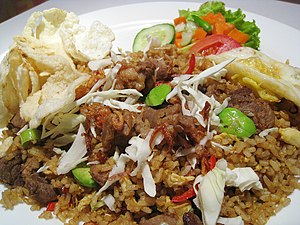
米は、栽培技術を獲得するか、他の場所から購入する能力を獲得したときに初めて、食事に取り入れられた。スラウェシ島の野生米の証拠は紀元前3000年にまで遡る。最も初期の栽培の証拠は、8世紀の中央ジャワ島の石碑文から得られ、王が米で税を徴収していたことを示している。米の栽培、米倉、水田を荒らすネズミの害虫のイメージは、ボロブドゥールのカルマウィバンガのレリーフに明らかである。男性、女性、動物間の労働分担は、インドネシアの米栽培で今も行われているもので、9世紀のプランバナン寺院のレリーフ彫刻に刻まれている。中部ジャワでは、水牛が鋤につながれ、女性が苗を植えたり穀物を臼でひいたり、男性が肩に棒(「ピクラン」)の両端に稲束を担いでいる。16世紀、インドネシア諸島を訪れたヨーロッパ人は、米を儀式や宴会で貴族に供される新しい権威ある食べ物と見ていた。
インドネシアの歴史における米の生産は、鉄器の開発と、野生のアジア水牛の家畜化(田畑の耕作用の水牛として、また肥料用の肥料として)と関連している。米の生産には太陽光への露出が必要である。かつて密林に覆われていたインドネシアの景観の多くは、過去1500年間の米栽培の発展に伴い、恒久的な畑や居住地のために徐々に開墾されてきた。
小麦

小麦はインドネシアの原産植物ではない。輸入や外国の影響、特に中国やオランダの影響により、インドネシア人は小麦を主原料とする食品、特に中国の麺類、インドのロティ、オランダのパンを好むようになった。インドネシアの中国人は、一般的な蒸しご飯の他に、麺類、バクパオ、チャクウェも主食と見なしていた。しかしインドネシア、特にジャワ島とスマトラ島では、米文化が非常に普及していたため、麺類のような小麦を主原料とする料理もおかずとして米と一緒に食べられることがあり、また中華まんやチャクウェのような他のものは軽食として扱われている。ヨーロッパ人、特にポルトガル人とオランダ人は、パンや様々な種類のベーカリーやペイストリーを導入した。これらのヨーロッパの主食は、今では手軽な朝食の代替品となっている。
インドネシアの小麦消費量は、1970年代にインドネシアのインスタントラーメン産業が登場して以来、新たな高みに達した。それ以来、インドネシアは世界の主要なインスタントラーメン生産国および消費国の一つとなっている。インドネシアは中国に次ぐ世界第2位のインスタントラーメン市場であり、2018年の需要は125.4億食に達した。今日、インスタントラーメンはインドネシアの家庭で手軽な温かい食事の主食となっている。インドミーなどの特定のブランドは、おなじみの名前となっている。
その他の主食

インドネシアの他の主食には、イモ類であるヤムイモ、サツマイモ、ジャガイモ、タロイモ、キャッサバなどがある。パンノキやジャックフルーツなどのデンプン質の果物や、トウモロコシなどの穀物も食べられている。「パペダ」と呼ばれるサゴの粥は、特にマルク諸島とパプアの主食である。サゴは水と混ぜて簡単なパンケーキとして調理されることが多い。サゴの他に、インドネシア東部の人々は野生のイモ類を主食として消費する。
「タラス」(タロイモの一種だがより大きく味が薄い)やパンノキなど、多くの種類の塊茎はインドネシア原産だが、他は他の地域から導入されたものである。ヤムイモはアフリカから導入され、ジャガイモ、サツマイモ、キャッサバ、トウモロコシはスペインの影響でアメリカ大陸から導入され、17世紀にジャワ島に到達した。キャッサバは通常、茹でたり、蒸したり、揚げたり、または人気のあるスナックである「クリピック・シンコン」(キャッサバチップス)として加工される。地元で「ティウール」として知られる乾燥キャッサバは、グヌンキドゥルやウォノギリのようなジャワ島の乾燥地帯で代替の主食であり、他の根菜類は特に厳しい時期に食べられている。トウモロコシはマドゥラ島やウォーレス線以東の島々(例えば小スンダ列島)のような乾燥地帯で食べられている。
野菜

インドネシア料理では、葉物野菜が幅広く使われている。例えば、「カンクン」、ほうれん草、「ゲンジェル」、「ムリンジョ」、パパイヤの葉、キャッサバの葉などである。これらはしばしばニンニクと一緒に炒められる。ほうれん草とトウモロコシは、「テム・クンチ」、ニンニク、エシャロットで風味付けされた「サユール・バヤム・ベニン」のようなシンプルな澄んだ汁物に使われる。澄んだ野菜スープには「サユール・オヨン」も含まれる。ユウガオ、ハヤトウリ、「ケロール」、ササゲ、ナス、「ガンバス」、「ベルストゥル」などの他の野菜は、切って炒め物、カレー、そして「サユール・アセム」、「サユール・ロデー」または「ラクサ」のようなスープに使われる。「ダウン・ウビ・トゥンブク」は、スマトラ、カリマンタン、スラウェシで一般的に見られる、すり潰したキャッサバの葉の料理である。「サユール・ソップ」は、キャベツ、カリフラワー、ジャガイモ、ニンジンをマカロニ、黒コショウ、ニンニク、エシャロットで味付けし、鶏肉や牛肉のブロスで煮込んだものである。同様のミックス野菜は、インドネシア中華料理の人気料理である「チャプチャイ」としても炒められる。「トゥミス・カンクン」は、人気の空芯菜の炒め物である。
シカクマメ、トマト、キュウリ、小型のニガウリなどの野菜は、「ララブ」のように生のまま食べられることが多い。大型のニガウリは通常茹でて食べる。「ケチョンブラン」とパパイヤの花芽は、一般的なインドネシアの野菜である。「ウラップ」は、味付けされスパイスの効いたすりおろしたココナッツと野菜を混ぜたものである。「アシナン・ブタウィ」は、保存野菜である。「ガドガド」と「プチェル」は、茹でた野菜にピーナッツベースの辛いソースをかけたサラダで、「カレドック」は生の野菜を使ったものである。
インドネシアにおける菜食主義

菜食主義はインドネシアでよく見られる。豊富な種類のベジタリアン料理と、肉の代替品が提供されている。ユーロモニター・インターナショナルが2018年に実施した調査によると、インドネシアは菜食主義の成長率が3番目に高い国である。 「ガドガド」、「カレドック」、「ケトプラック」、「タウゲゴレン」、「プチェル」、「ウラップ」、「ルジャック」、「アシナン」などの料理はベジタリアン料理である。しかし、「ガドガド」、「カレドック」、「ケトプラック」のようなピーナッツソースを使う料理には、風味付けのために「テラシ」と呼ばれる少量のエビペーストが含まれている場合がある。エビペーストは、ララブ( assorted fresh vegetables)と一緒に提供される辛いサンバルチリペーストに風味を加えるためにもよく使われる。大豆の発酵製品であるテンペ、「タフ」(豆腐)、「オンチョム」は、肉の代替品として、また植物性タンパク質源として広く普及している。現代のフュージョン料理では、テンペはミートパティの代わりとして使われ、テンペバーガーとして提供されている。
ほとんどのインドネシア人は厳格な菜食主義を実践しておらず、味、好み、経済的、健康上の理由から野菜や菜食料理を摂取することがある。それでも、宗教的な理由で菜食主義を実践する少数のインドネシア仏教徒は存在する。
肉と魚
インドネシアの食事における主要な動物性タンパク質源は、主に家禽と魚であり、牛肉、水牛、ヤギ肉、羊肉などの肉類もインドネシアの市場で一般的に見られる。
鶏肉
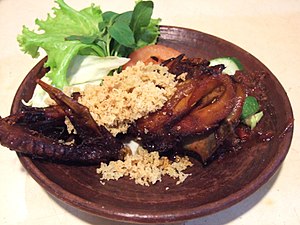
最も一般的に消費される家禽は鶏肉と鴨肉で、ハト、ウズラ、ツルクイナなどの野生の沼地の鳥も消費される。伝統的に、インドネシア人は「アヤム・カンポン」(村の鶏)として知られる放し飼いの鶏を飼育している。一般的な飼育鶏と比較して、これらの村の鶏は痩せており、肉はわずかに固い。「アヤム・ゴレン」(フライドチキン)と「アヤム・バカール」(グリルチキン)の様々なレシピは、インドネシア全土で一般的に見られる。揚げたり焼いたりする以外に、鶏肉は「sup ayam」や「ソト・アヤム」のようなスープとして調理したり、「オポール・アヤム」のようにココナッツミルクで調理したりすることもある。鶏肉サテもインドネシアで一般的に見られる。串に刺してバーベキューにし、ピーナッツソースを添えて提供する。人気の鶏肉レシピには、ジョグジャカルタの「アヤム・ゴレン・カラスン」、パダンの「アヤム・バカール・パダン」、ロンボクの「アヤム・タリワン」、バリの「アヤム・ブトゥトゥ」、そして「アヤム・ゴレン・レンクアス」(ガランガル風味のフライドチキン)がある。
肉

牛肉とヤギ肉は、インドネシアで最も一般的に消費される肉であり、「kerbau」(水牛)と羊肉も消費されるが、水牛は水田を耕すのに役立ち、羊は羊毛のために飼育されたり、伝統的な娯楽である羊の闘いに使われたりするため、消費量は少ない。イスラム教徒が多数を占める国として、インドネシアのイスラム教徒はイスラム教のハラールの食事規定に従い、豚肉の消費を禁じている。
イスラム教徒以外の人が多いインドネシアの他の地域では、イノシシ肉と豚肉が一般的に消費される。ハラールでない肉を使った料理は、バリ、北スマトラ、北スラウェシ、東ヌサトゥンガラ、マルク、西カリマンタン、中央カリマンタン、北カリマンタン、西パプア、パプアなどの州や、インドネシアの主要都市の中華街で見られる。今日、より大きなイスラム市場に対応するために、インドネシアのほとんどのレストランや飲食店は、豚肉やハラールでない肉を提供せず、調理にラードを使用しないことを示すハラールサインを出している。圧倒的なイスラム教徒の人口と、比較的少ない牛の人口により、今日インドネシア人はオーストラリア、ニュージーランド、米国からの牛肉の輸入に大きく依存しており、インドネシア市場での牛肉の不足と価格上昇につながることが多い。
肉は、牛肉、ヤギ肉、または羊肉の「ルンダン」のように豊富なスパイスとココナッツミルクで調理したり、串に刺して味付けし、鶏肉や羊肉をサテとしてグリルしたり、バーベキューにしたり、スライスして「ソト」のように豊かなブロススープで調理したりすることができる。羊肉と様々な内臓は、ソトスープや「グライ」カレーの材料として使用できる。ヒンドゥー教徒が多数を占めるバリでは、「バビグリン」(豚の丸焼き)が地元の人々やイスラム教徒以外の観光客に人気がある。一方、北スマトラのバタク族は、「バビパンガン」という同様の料理がある。イノシシもパプアで一般的に消費される。肉は薄切りにして乾燥させた「デンデン」(ジャーキー)にしたり、「abon」(肉フレーク)にしたりすることもできる。「dendeng celeng」は、インドネシアの「乾燥ジャーキー」のイノシシ肉である。ウサギもインドネシアの山岳地帯で食用として消費されている。
鹿肉などの猟肉は、インドネシアの一部の地域で販売および消費されている可能性がある。カリマンタン、西ヌサトゥンガラ、東ヌサトゥンガラ、パプアでは、鹿肉を見つけることができ、通常は狩猟によって野生で入手する。その他の珍しい、そしてしばしば物議を醸すエキゾチックな肉には、インドネシア中華料理やジャワ料理で消費されるカエルの足やスッポン、ジョグジャカルタ、西ヌサトゥンガラ、南スラウェシで消費される馬肉、バリやインドネシア東部で消費されるカメの肉、ヘビ、「biawak」(オオトカゲ)、「paniki」(フルーツコウモリ)犬肉、猫肉、ミナハサ料理で消費される野ネズミがある。北スマトラのバタク料理も犬肉の調理に精通しているが、その消費は中央ジャワでは減少している。ワニ、リス、ジャコウネコ、サルなどのエキゾチックで珍しい猟肉も、インドネシアの野生地域で販売および消費されている可能性がある。
魚

群島国家であるインドネシアでは、シーフードが豊富であり、特に沿岸地域に住むインドネシアの住民によく消費されている。魚は、スラウェシやマルク諸島などのインドネシア東部地域で特に人気があり、ほとんどの人が漁師として働いている。どちらの地域も広大な海があり、多くの種類のシーフードがもたらされる。
インドネシア料理で人気のシーフードには、カツオ、マグロ、サバ、マナガツオ、カマスサワラ、サバヒー、アジ、アイゴ、アバリスト、カンパチ、グルクマ、ムロアジ、ヨコイトヨリ、マトウダイ、ハタ、タイ、イワシ、メカジキ、サメ、エイ、イカまたはコウイカ、エビ、カニ、ガザミ、ムール貝などがある。
シーフードはインドネシア全土で一般的に消費されているが、マルク諸島、ゴロンタロ半島、ミナハサ(北スラウェシ)料理で特に人気がある。シーフードは通常、グリル、煮込み、または揚げられる。「イカン・バカール」は、インドネシア全土で見られる人気の焼き魚料理である。スパイスで炒めたり、スープに入れたりする調理法も可能である。塩漬け魚は、塩で保存されたシーフードであり、インドネシアの市場でも見られる。
淡水漁業は、内陸地域や大きな川や湖のある地域で見られる。淡水魚は、西ジャワのスンダ料理で人気があり、北スマトラのバタク地方のトバ湖で捕獲または養殖されたり、リアウ、ジャンビ、南スマトラのマレー地方やカリマンタンの大きな川から採取されたりする。人気の淡水魚には、コイ、グラミー、ナマズ、「パンガシウス」、ライギョ、「トリコガステル」、キノボリウオ、ナイルティラピア、モザンビークティラピアなどがある。
昆虫

タイとは異なり、インドネシアでは昆虫は人気の食材ではなく、屋台料理として広く入手できるものでもない。ジャワ島では、地元の人々は特定の種類の昆虫を捕獲、飼育、販売しており、通常はペットの鳥の餌として新鮮または生きた状態で販売されている。それにもかかわらず、伝統的にインドネシアのいくつかの文化は、特にイナゴ、コオロギ、シロアリ、またサゴヤシゾウムシ、ミツバチ、トンボの幼虫を消費することで知られている。ジャワ島とカリマンタン島では、イナゴとコオロギは通常軽く衣を付けてパーム油で揚げ、「クリピック」のスナックとしてカリカリにしている。小型のイナゴ、コオロギ、シロアリは、昆虫の化石に似た「レンペ」バッタークラッカーとして作られることがある。モンスーンの雨季には、羽のあるシロアリが電球に引き寄せられて交尾するため豊富になる。地元の人々は通常、ランプの下に水の入ったバケツを置いて羽のあるシロアリを捕獲し、羽をもぎ取り、タンパク質が豊富な追加のスナックとしてシロアリをローストする。東ジャワのバニュワンギには、「ボトックタウォン」(ミツバチのボトック)と呼ばれる特別な料理があり、これはミツバチの幼虫を含む蜂の巣で、細かく刻んだココナッツとスパイスで味付けし、バナナの葉のパッケージに包んで蒸したものである。カリマンタンのダヤク族、またインドネシア東部のモルッカ族とパプア族は、「ulat sagu」(文字通りサゴイモムシ)またはサゴヤシゾウムシの幼虫を消費することで知られている。このタンパク質が豊富な幼虫はパプアでは珍味とされており、消費する前にローストされることが多い。地元の人々はまた、幼虫を生または生きたまま食べるのが一般的である。バリでは、トンボもペペスに加工して消費される。
スパイスとその他の調味料

「Rempah」はインドネシア語でスパイスを意味し、「ブンブ」はインドネシア語でスパイスミックスまたは調味料を意味し、特定のスパイスミックス、ソース、調味料ペーストの名前によく登場する。
「スパイス諸島」として世界中に知られているマルク諸島は、その地のスパイスを世界の料理に導入するのに貢献した。ナツメグまたはメース、クローブ、パンダンリーフ、クルワック、ガランガルなどのスパイスはインドネシア原産である。黒胡椒、ウコン、レモングラス、エシャロット、シナモン、カンドルナッツ、コリアンダー、タマリンドはインドから、ショウガ、ネギ、ニンニクは中国から導入された可能性が高い。これらのアジア大陸からのスパイスは古く、古代に導入されたため、インドネシア料理に不可欠な材料となった。
古代には、スンダ王国と後のバンテン・スルタン国は、世界の主要な黒胡椒生産国としてよく知られていた。シュリーヴィジャヤとマジャパヒトの海洋帝国も、スパイス諸島と中国およびインドとの間の儲かるスパイス貿易から利益を得ていた。その後、オランダ東インド会社がインドネシアと世界とのスパイス貿易を支配した。
サンバル

インドネシア人の辛い食べ物への好みは、16世紀にスペイン人が新世界からこの地域に唐辛子を導入したことで豊かになった。その後、辛い「サンバル」はインドネシア料理の重要な一部となった。
インドネシアにはおそらく最も豊富な種類のサンバルがある。インドネシア諸島には、実に300種類もの「サンバル」が存在する。その辛さはマイルドなものから非常に辛いものまで多岐にわたる。サンバルはインドネシア中で多くのバリエーションに発展し、最も人気のあるものの一つは「サンバル・テラシ」(サンバル・ブラチャン)と「サンバル・マンガ・ムダ」(未熟マンゴーのサンバル)である。「サンバル・テラシ」は、唐辛子、テラシと呼ばれる鋭い発酵エビペースト、ピリッとしたライム果汁、砂糖、塩をすべて乳鉢とすりこぎで潰したものである。ダブダブは、ゴロンタロと北スラウェシスタイルのサンバルで、刻んだ新鮮なトマト、唐辛子、ライム果汁を混ぜたものである。

サンバル、特にサンバル・ウレックやサンバル・テラシは、サンバル・ラジャ(クタの料理)、テロン・バラド、デンデン・バラド、アヤム・ブンブ・ルジャック、サンバル・ゴレン・アティなど、多くの料理の基本材料にもなる。
ソースと調味料
醤油もインドネシア料理における重要な調味料である。「Kecap asin」(塩辛い、または一般的な醤油)は中華料理から取り入れられたが、インドネシア人は醤油にパームシュガーをたっぷり加えて独自の「ケチャップ・マニス」(甘い醤油)を開発した。甘い醤油は、サテや焼き魚などのバーベキュー肉や魚の重要なマリネ液である。甘い醤油は、「セムール」というインドネシアの煮込み料理にとっても重要な材料である。
ピーナッツソース

インドネシア料理の主要な特徴の一つは、ピーナッツが「サテ」、「ガドガド」、「カレドック」、「ケトプラック」、「プチェル」など、多くの代表的なインドネシア料理に幅広く使われていることである。これらの料理はすべて、風味付けのためにたっぷりの「bumbu kacang」(ピーナッツソース)を使用している。「ガドガド」や「サテ」などは、インドネシアの国民食とされている。
16世紀にメキシコからポルトガル人やスペイン人の商人によって伝えられたピーナッツは、インドネシア料理の主要な食材として位置づけられた。ピーナッツは東南アジアの熱帯環境でよく育ち、今日では多くのレシピで、ローストして細かく刻んだものが見られる。丸ごと、半分、または砕いたピーナッツは、様々な料理の付け合わせに使われたり、「オタコタック」や「クタン」のための「サンバル・カチャン」(ひき肉と揚げピーナッツを混ぜたもの)のようなマリネ液やディップソースに使われたりする。ピーナッツから抽出されるピーナッツオイルは、インドネシアで最も一般的に使われる食用油の一つである。
「Bumbu kacang」またはピーナッツソースは、甘くてベタベタしたソースというよりは、洗練された素朴な調味料である。揚げたピーナッツ、グラ・ジャワ(ココナッツシュガー)、ニンニク、エシャロット、ショウガ、タマリンド、レモン汁、レモングラス、塩、唐辛子、粒胡椒、甘い醤油など、様々な材料を一緒に挽いて水と混ぜて適切な粘度にしたもので、香ばしさ、甘さ、酸味、辛味の繊細なバランスがとれているべきである。良いピーナッツソースの秘訣は、「濃すぎず、水っぽすぎない」ことである。インドネシアのピーナッツソースは、タイのバージョン(ハイブリッドな適応)よりも甘みが少ない傾向がある。「ガドガド」は「ブンブ・カチャン」と特に関連の深い人気料理であり、インドネシア全土で食べられている。
ココナッツミルク
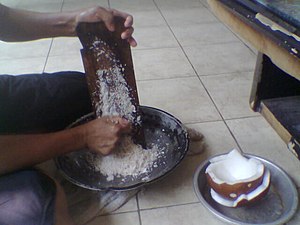
ココナッツは熱帯のインドネシアに豊富にあり、古くからインドネシア人はこの植物を様々な方法で利用してきた。諸島全体で料理にココナッツミルクが幅広く使われていることは、インドネシア料理のもう一つの共通の特徴である。ココナッツミルクは、「ルンダン」、「ソト」、「グライ」、「ミー・コチョック」、「サユール・ロデ」、「グデッグ」、「オポール・アヤム」のような塩味の料理から、「es チェンドル」、「エス・ドゲル」のようなデザートまで、幅広いレシピで使われている。
ココナッツミルクの使用は、インドネシア料理に限ったことではない。インド、サモア、タイ、マレーシア、フィリピン、ブラジルの料理にも見られる。しかし、インドネシアでは特にミナンカバウ料理やゴロンタロ料理でココナッツミルクの使用が非常に広範である。ただし、ミナハサ(北スラウェシ)料理では、「クラッパルタルト」のようなミナハサのケーキやデザートを除いて、ココナッツミルクは一般的に使用されない。

インドネシア料理には、薄いココナッツミルクと濃いココナッツミルクの2種類がある。違いは水分と油分の含有量による。薄いココナッツミルクは通常、「サユール・ロデ」や「ソト」のようなスープに使われ、濃い方は「ルンダン」やデザートに使われる。伝統的な市場では、すりおろしたばかりの新鮮なココナッツの果肉から作られるか、スーパーマーケットで加工されたカートン入りのものが見られる。
ココナッツの果肉からココナッツミルクを抽出した後、「ampas kelapa」(残ったココナッツの果肉)は、「urap」で、味付けされスパイスの効いたすりおろしたココナッツの果肉と野菜を混ぜて使用できる。残ったすりおろしたココナッツは、ソテーして味付けし、「セルンデン」という、ほとんど粉末状の甘くてスパイシーな細かく刻んだココナッツを作ることもできる。ケリシックペーストは、「ルンダン」を濃くするために加えられる、ココナッツの果肉のもう一つの用途である。豊かな味を出すために、一部の家庭では「ウラップ」や「セルンデン」に、残ったものではなく新鮮なすりおろしたココナッツを使うことにこだわる。「セルンデン」は、「セルンデン・ダギン」(牛肉のセルンデン)のような肉料理と混ぜたり、「ソト」や「クタン」(もち米)のような他の料理の上に振りかけたりすることができる。ココナッツの多用の一例は、マカッサルの「ブラサ」で、バナナの葉に包んだ米をココナッツミルクで炊き、セルンデンに似た粉状のココナッツを振りかけたものである。
調理法

インドネシアの一般的な料理のほとんどは、主要な材料と調理法にちなんで名付けられている。例えば、「アヤム・ゴレン」は「ayam」(鶏肉)と「goreng」(揚げる)から成り、フライドチキンを意味する。「ミー・ゴレン」は焼きそば、「イカン・バカール」は焼き魚、「udang rebus」は茹でエビ、「バビ・パンガン」はローストポーク、「tumis kangkung」は空芯菜の炒め物である。インドネシアの台所での調理法は、「goreng」(揚げる)は少量の油で揚げるか、多量の食用油で揚げるか、「tumis」(炒める)、「sangrai」(ソテーする)である。焙煎法は「bakar」(グリルする)で、通常木炭、薪、またはココナッツの殻を使用し、「panggang」(焼く/ローストする)は通常オーブンを使用するものを指す。その他の方法としては、「rebus」(茹でる)、「kukus」(蒸す)、「asap」/「salai」(燻製する)がある。
調理に使う火は、強火でも弱火でも、ゆっくり煮込むことができる。ナシゴレンの調理には通常強火を使うが、本格的な「ルンダン」は、牛肉、スパイス、ココナッツミルクを肉がキャラメル化し、ココナッツミルクの水分がすべて蒸発するまでゆっくり煮込むために弱火が必要である。伝統的なインドネシアの「dapur」(台所)は通常、薪を燃料とするかまどを使用するが、現代の家庭では液化石油ガスを燃料とするストーブや電気ストーブを使用している。材料は細かく切ったり、薄切りにしたり、ペースト状に挽いたりする。調理器具は「wajan」(中華鍋)、「penggorengan」(フライパン)、「panci」(大鍋)、包丁、数種類のスプーンとフォーク、「parutan」(おろし金)、「cobek」と「ulekan」(石製のすり鉢とすりこぎ)である。伝統的にインドネシア人は石製のすり鉢とすりこぎでスパイスや材料を粗いペーストや細かいペーストに挽いていた。今日ではほとんどの家庭でこの作業にブレンダーやフードプロセッサーを使用している。伝統的なインドネシアの調理器具は通常、石、土器、陶器、木材、編み込んだ竹や籐の容器またはフィルターで作られていたが、現代の調理器具、皿、容器は金属(鉄、錫、ステンレス鋼、アルミニウム)、陶磁器、プラスチック、ガラスを使用している。
Initially during the early years of Indonesian independence, the ubiquitous and highly popular nasi goreng was considered the national dish of the republic, albeit at that time was unofficial. Its simplicity and versatility has contributed to its popularity and made it as a staple among Indonesian households—colloquially considered the most "democratic" dish since the absence of an exact and rigid recipe has allowed people to do anything they want with it.
Nasi goreng that is commonly consumed daily in Indonesian households was considered the quintessential dish that represent an Indonesian family. It is in the menu, introduced, offered and served in Indonesian Theatre Restaurant within the Indonesian pavilion at the 1964 New York World's Fair. Howard Palfrey Jones, the US ambassador to Indonesia during the last years of Sukarno's reign in the mid 1960s, in his memoir "Indonesia: The Possible Dream", said that he likes nasi goreng. He described his fondness for nasi goreng cooked by Hartini, one of Sukarno's wives, and praised it as the most delicious nasi goreng he ever tasted. Nevertheless, other widely popular Indonesian dishes, such as satay, soto and gado-gado are also considered strong contenders. Soto is ubiquitous in Indonesia and considered one of Indonesia's national dishes.
In 2014, the Indonesian Ministry of Tourism and Creative Economy in an effort to promote Indonesian cuisine, has chosen tumpeng as an official Indonesian national dish. Technically tumpeng refer to the rice cone in the center, while the surrounding various dishes might be taken from any choice of various Indonesian dishes—thus was considered ideal as a national dish that binds the diversity of Indonesia's various culinary traditions. Subsequently the designation of tumpeng as the single national dish of Indonesia was considered insufficient to describe the diversity of Indonesian culinary traditions. Later in 2018, the same ministry has chosen another additional 5 national dishes of Indonesia; they are soto, satay, nasi goreng, rendang and gado-gado.
Satay and soto are notable and the natural choice to be promoted as Indonesian national dish, since they had transcends the cultural boundaries of myriad ethnic groups of Indonesia—those dishes has been extremely localised and has branched into various recipes nationwide. For example, there are rich variants of satay and soto recipes throughout Indonesia; from Sumatra to Eastern Indonesia. Each cultures, ethnics, or even cities had adopted these dishes, and thus developed their own version in accordance to their own culture, tradition, creativity, localised taste and preference, also the availability of local ingredients.
Regional dishes
Jakarta

Diverse and eclectic, Betawi cuisine of Jakarta draw culinary influences from Chinese, Malay, Sundanese, to Arab, Indian and European. Popular Betawi dishes include nasi uduk (coconut rice), sayur asem (sweet and sour vegetable soup), asinan (salad of pickled vegetables), gado-gado, (boiled or blanched vegetables salad in peanut sauce), ketoprak, (vegetables, tofu, rice vermicelli and rice cake in peanut sauce), and kerak telor (spiced coconut omelette). Born from a creole or hybrid phenomena, the Betawi cuisine is quite similar to the Peranakan cuisine.
West Java

A textural speciality of Sunda (West Java) is karedok, a fresh salad made with long beans, bean sprouts, and cucumber with a spicy peanut sauce. Lalab fresh vegetables served with spicy sambal dipping sauce is ubiquitous in Sundanese households and eating establishments. Other Sundanese dishes include mie kocok which is a beef and egg noodle soup, and soto bandung, a beef and vegetable soup with daikon and lemongrass. A hawker favourite is kupat tahu (pressed rice, bean sprouts, and tofu with soy and peanut sauce). Colenak (roasted fermented cassava tapai with sweet coconut sauce) and ulen (roasted brick of sticky rice with peanut sauce) are dishes usually eaten warm.
Central Java

The food of Central Java is renowned for its sweetness, and the dish of gudeg, a curry made from jackfruit, is particularly sweet. The city of Yogyakarta is renowned for its ayam goreng (fried chicken) and klepon (green rice-flour balls with palm sugar filling). Surakarta's (Solo) specialities include nasi liwet (rice with coconut milk, unripe papaya, garlic and shallots, served with chicken or egg) and serabi (coconut milk pancakes topped with chocolate, banana or jackfruit). Other Central Javanese specialities include pecel (peanut sauce with spinach and bean sprouts), lotek (peanut sauce with vegetable and pressed rice), and opor ayam (braised chicken in coconut sauce).
East Java
The food of East Java is similar to that of Central Java. East Java foods tend to be less sweet and more spicier compare to the Central Javanese ones. Fish and fish/seafood products are quite extensively, e.g. terasi (dried shrimp paste) and petis udang (shrimp paste). Some of the more popular foods are lontong kupang (tiny clams soup with rice cakes), lontong balap (bean sprouts and tofu with rice cakes), sate klopo (coconut beef satay), semanggi surabaya (marsilea leaves with spicy sweet potato sauce), pecel lele (deep fried catfish served with rice and sambal), rawon (dark beef soup). Food from Malang includes bakso malang (meatball soup with won ton and noodles) and orem-orem (pressed rice, tempe, sprouts, soy sauce, coconut, and peanuts).
Madura

Madura is an island on the northeastern coast of Java and is administered as part of the East Java province. Like the Eastern Javanese foods which use petis udang, Madura foods add petis ikan which is made from fish instead of shrimp. The Madura style satay is probably the most popular satay variants in Indonesia. Some of its popular dishes are sate ayam Madura (chicken satay with peanut sauce), soto Madura (beef soup). There is also a mutton variant of Madura satay, Madura goat satay. Sup Kambing mutton soup is also popular in Madura. As a leading salt production center in Indonesian archipelago, Madura dishes are often saltier compared to other Eastern Javanese foods.
Bali

Balinese cuisine dishes include lawar (chopped coconut, garlic, chilli, with pork or chicken meat and blood). Bebek betutu is duck stuffed with spices, wrapped in banana leaves and coconut husks cooked in a pit of embers. Balinese sate, known as sate lilit, is made from spiced mince pressed onto skewers which are often made from lemon grass sticks. Babi guling is a spit-roasted pig stuffed with chilli, turmeric, garlic, and ginger. Basa gede or basa rajang is a spice paste that is a basic ingredient in many Balinese dishes.
Batak

Batak people use either pork or even dog to make saksang. Another Batak pork speciality is babi panggang in which the meat is boiled in vinegar and pig blood before being roasted. Another batak dish, ayam namargota, is chicken cooked in spices and blood. Another notable Batak dish is arsik, the carp fish cooked with spices and herbs. Within Batak cuisine, andaliman (Zanthoxylum acanthopodium) is often used as a spice.
Aceh
Arab, Persian, and Indian traders influenced food in Aceh although flavours have changed a lot their original forms. Amongst these are curry dishes known as kare or gulai, which are rich, coconut-based dishes traditionally made with beef, goat, fish or poultry, but are now also made with tofu, vegetables, and jackfruit. The popular Aceh food such as roti cane, mie aceh and nasi gurih.
West Sumatra

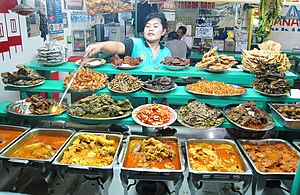
Buffaloes are a symbol of West Sumatra and are used in rendang, a rich and spicy buffalo meat or beef dish, which is also the signature dish of Minangkabau culture. In 2017, rendang was chosen as the "World's Most Delicious Food" by the CNN Travel reader's choice. Padang food comes from West Sumatra, and they have perhaps the richest variants of gulai, a type of curried meat, offal, fish or vegetables. Padang favourite includes asam padeh (sour and spicy fish stew), sate Padang (Padang satay), soto Padang (Padang soto) and katupek sayua (ketupat rice dumpling in vegetable soup). Dishes from the region include nasi kapau from Bukittinggi, which is similar to Padang food but uses more vegetables. Ampiang dadiah (buffalo yogurt with palm sugar syrup, coconut flesh and rice) and bubur kampiun (Mung bean porridge with banana and rice yogurt) are other West Sumatran specialties.
Traditionally, Minangkabau people adheres to merantau (migrating) culture, and they are avid restaurant entrepreneurs. As a result, Padang food restaurant chains can be found throughout Indonesia and neighbouring countries, likely making it the most popular regional dish in Indonesia. Outside of West Sumatra, such as in Java, most Padang Restaurants still use buffalo to make rendang, but claim it is Rendang Sapi for selling purposes, due to buffalo meat being "inferior" and cheaper than cow meat. Buffalo meat is harder, so it is more suitable for rendang which has a cooking time of at least 3 hours, and presents a coarser texture and a redder color compared to cow meat when it is fully cooked.
East Sumatra

The cuisine of east coast of Sumatra is referring to the culinary tradition of ethnic Malays of Indonesian Sumatran provinces facing Malacca strait; which includes Riau, Riau Islands, Jambi provinces and coastal North Sumatra in Melayu Deli areas in and around Medan. Because of close ethnic kinship and proximity to Malaysian Malays, many dishes are shared between the two countries. For example nasi lemak, the national dish of Malaysia, and also nasi ulam are considered native dishes in Riau and Jambi. Malay cuisine also shares many similarities with neighboring Minangkabau cuisine of West Sumatra, South Sumatra, and also Aceh; such as sharing gulai, asam pedas, pindang, kari, lemang and rendang. This is due to the fact that the Minangkabau are culturally closely related to the Malays. Tempoyak fermented durian sauce and sambal belacan are the familiar condiments in both Sumatra and Malay Peninsula. Variants of peranakan cuisine such as laksa spicy noodle and otak-otak are also can be found in Riau Islands and Medan. Seafood dishes are popular in archipelagic Riau Islands province, while fresh water fishes from Sumatran rivers, such as patin, catfish, carp and gourami are popular in Riau and Jambi. Gulai ikan patin is a signature dish of Pekanbaru, while gulai ketam (crab gulai) and nasi goreng teri Medan (Medan anchovy fried rice) are the signature dishes of Medan.
South Sumatra

The city of Palembang is the culinary centre of South Sumatra and is renowned for its pempek, a deep fried fish and sago dumpling that is also known as empek-empek. Pempek is served in distinctive kuah cuko, a sweet, sour and spicy sauce made from palm sugar, chili, tamarind and vinegar. Pempek derivatives dishes are tekwan soup of pempek dumpling, mushroom, vegetables, and shrimp, lenggang or pempek slices in omelette. Mie celor is a noodle dish with egg in coconut milk and dried shrimp, it is a Palembang speciality.
The cuisine of Palembang demonstrates various influences, from native Palembang Malay taste to Chinese and Javanese influences. Pempek is said to be influenced by Chinese fish cake akin to surimi, while the preference of mild sweetness is said to be of Javanese influence. South Sumatra is home to pindang, a sweet, sour and spicy fish soup made from soy sauce and tamarind. Pindang dishes usually uses either freshwater fishes and seafood as ingredients. Ikan brengkes is fish in a spicy durian-based sauce. Tempoyak is a sauce of shrimp paste, lime juice, chilli and fermented durian, and sambal buah is a chilli sauce made from fruit.
North Sulawesi
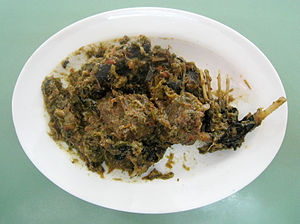
Manado cuisine of Minahasan people from North Sulawesi features the heavy use of meat such as pork, fowl, and seafood. Woku is a type of seafood dish with generous use of spices, often making up half the dish. The ingredients include lemongrass, lime leaves, chili peppers, spring onion, shallots, either sautéed with meat or wrapped around fish and grilled covered in banana leaves. Other ingredients such as turmeric and ginger are often added to create a version of woku. Other Minahasan signature dishes are tinutuan, chicken tuturuga, rica-rica and cakalang fufu.
Foreign colonial influence played a role in shaping Minahasan cuisine. Several cakes and pastries explicitly show Dutch, Portuguese and Spanish influences such as klappertaart and panada. Brenebon (from Dutch bruin (brown) and boon (bean)) is a pork shank bean stew spiced with nutmeg and clove. Minahasan roast pork similar to lechon in the Philippines or pig roast in Hawaii are served in special occasions, especially weddings. Other unusual and exotic meats such as dog, bat, and forest rat are regularly served in North Sulawesi region. Paniki is the bat dish of Minahasa.
Gorontalo

The strategic location of Gorontalo, between the Celebes Sea and Pacific Ocean in the north, and also Gulf of Tomini in the south, has made the Gorontalo region a strategic shipping route in the past. This long past history has formed the roots of a unique and distinctive culture in Gorontalo, including its unique dishes. Therefore, Gorontalo is also known as the land of spices with a unique taste of culinary.
Gorontalese cuisine known for its fresh seafood, prepared using a full-palette of spices and herbs. Home of some Gorontalese delicacies such as binte biluhuta, ayam iloni, ikan iloni, sate tuna, tabu moitomo, sate balanga, sagela, pilitode, and bilentango.
Gorontalo cuisine is also marked by a multi-cultural influence from other communities who migrated to Gorontalo, such as Arabs and Chinese culture. Moreover, Gorontalo's pastries are also famous for their sweetness and it has been influenced by European culture brought by the Dutch.
In 2016, the Gorontalese recipe book: "Trailing the Taste of Gorontalo" won as the "Best in the World" at the Gourmand World Cookbook Award in Yantai, China for the Asian Cuisine from Asian Books category.
South Sulawesi

Makassar is one of the culinary centres in Indonesia. Home of some Bugis and Makassar delicacies such as Coto, Konro, Pallubasa and Mie Kering. All of these Makassar foods are usually consumed with burasa, a coconut milk rice dumpling wrapped in a banana leaf, to replace steamed rice or ketupat. As a big fish market centre, Makassar is also famous for its seafood. Various ikan bakar or grilled fish are popular and commonly served in Makassar restaurants, warung and foodstalls, such as ikan bolu bakar (grilled milkfish). Sop saudara from Pangkep and Kapurung from Palopo are also famous dishes of South Sulawesi. Another popular cuisine from Makassar is Ayam Goreng Sulawesi (Celebes fried chicken); the chicken is marinated in a traditional soy sauce for up to 24 hours before being fried into a golden colour. The dish is usually served with chicken broth, rice and special sambal (chilli sauce).
In addition, Makassar is also home of traditional sweet snacks such as pisang epe (pressed banana), as well as pisang ijo (green banana). Pisang Epe is a flat-grilled banana which is pressed, grilled, and covered with palm sugar sauce and sometimes eaten with durian. Many street vendors sell pisang epe, especially around the area of Losari beach. Pisang ijo is a banana covered with green colored flours, coconut milk, and syrup. Pisang ijo is sometimes served iced, and often sold and consumed as iftar to break the fast during Ramadhan.
With a drier climate in Nusa Tenggara archipelago, there is less rice and more sago, corn, cassava, and taro compared to central and western Indonesia. Fishes are popularly consumed, including sepat (Trichogaster), which is shredded fish in coconut and young-mango sauce. Lombok's sasak people enjoy spicy food such as ayam taliwang which is roasted chicken served with peanut, tomato chilli and lime dip. Pelecing is a spicy sauce used in many dishes made with chilli, shrimp paste, and tomato. A local shrimp paste called lengkare is used on the island of Lombok. Sares is made from chilli, coconut juice and banana palm pith and is sometimes mixed with meat. Non meat dishes include kelor (hot soup with vegetables), serebuk (vegetables mixed with coconut), and timun urap (cucumber with coconut, onion and garlic).
In East Nusa Tenggara, majority of its inhabitants are Catholics, hence pork is commonly consumed. Popular Timor dishes are Se'i smoked meat (usually pork), and katemak vegetable soup.
Maluku and Papua

The Maluku Islands' cuisine is rich with seafood, while the native Papuan food usually consists of roasted boar with tubers such as sweet potato and taro. Various types of ikan bakar (grilled fish) or seafood are eaten with spicy colo-colo condiment. The staple food of Maluku and Papua is sago, either as a pancake or sago congee called papeda, usually eaten with yellow soup made from tuna, red snapper or other fishes spiced with turmeric, lime, and other spices.
Foreign influences

Indian influences
Indian influence can be observed in Indonesia as early as the 4th century. Following the spread of Islam to Indonesia, Muslim Indian as well as Arab influences made their way into Indonesian cuisine. Andreas Maryoto, a journalist which focus on culinary history, suggests there was at least two waves of Indian culinary influence that made its way into Indonesia. The early arrival was marked by the adoption of Hindu culture that still can be seen in Java. The second wave was came from the Mughal Empire, which was influenced by Islamic culture that has entered the archipelago. This second wave of Indian culinary influence can be seen throughout most of northern Sumatra, especially in Aceh and West Sumatra provinces. Examples include Indian martabak and kari (curry) that influenced Sumatran cuisines of Aceh, Minangkabau, and Malay; in addition to Betawi and coastal Javanese cuisine. Some of Aceh and Minangkabau dishes such as roti cane, nasi biryani, nasi kebuli, and gulai kambing can trace its origin to Indian influences.
Arab influences
Arab Indonesians brought their legacy of Arab cuisine—originally from Hadhramaut, Hejaz and Egypt—and modified some of the dishes with the addition of Indonesian ingredients. The Arabs arrived in the Nusantara archipelago to trade and spread Islam. Nasi kebuli for example, is a popular dish among Arab Indonesian community that has made its way into mainstream Indonesian cuisine. In Maluku, kue asida served during Ramadan for iftar, is believed to be derived from the Middle Eastern asida that was introduced by Arab merchants into the Maluku Islands.
Chinese influences

Chinese immigration to Indonesia started in the 7th century, and accelerated during Dutch colonial times, thus creating the fusion of Chinese cuisine with indigenous Indonesian style. Similar Chinese-native fusion cuisine phenomena is also observable in neighbouring Malaysia and Singapore as peranakan cuisine.
The Chinese cooking style that has influenced Indonesian cuisine was mainly Hokkien cuisine. Some of Chinese Indonesian food retain its Hokkien name; e.g. kwetiau, bakmi, bakcang, bihun and lumpia. Some popular Indonesian dishes trace its origin to Chinese influences such as; bakso, soto mie, soto, bakpau, nasi goreng, mie goreng, tahu goreng, siomay, pempek, nasi tim, cap cai, fu yung hai and swikee. Some of this Chinese-influenced dishes has been so well-integrated into Indonesian mainstream cuisine that many Indonesian today might not recognise their Chinese-origin and considered them their own.
The Dutch arrived in Indonesia in the 16th century in search of spices. When the Dutch East India Company (VOC) went bankrupt in 1800, Indonesia became a treasured colony of the Netherlands. Through colonialism, Europeans introduced bread, cheese, barbecued steak and pancake. Bread, butter and margarine, chocolate sprinkles, sandwiches filled with ham, cheese or fruit jam, poffertjes, pannekoek and Dutch cheeses are commonly consumed by colonial Dutch and Indos during the colonial era. Some of native upperclass ningrat (nobles) and educated native were exposed to European cuisine; This cuisine was held in high esteem as the cuisine of the upper class of Dutch East Indies society.
This led to adoption and fusion of European cuisine into Indonesian cuisine. Several Indonesian food can trace its origin from Dutch influence, such as kue odading that was derived from Dutch oliebollen, semur from Dutch smoor, perkedel from frikadeller, sop senerek from erwtensoep, selat solo (solo salad) from holland biefstuk.

Some dishes created during the colonial era were influenced by Dutch cuisine, including roti bakar (grilled bread), roti buaya, macaroni schotel (macaroni casserole), pastel tutup (Shepherd's pie), bistik jawa (Javanese beef steak), erten (pea soup), brenebon (kidney bean soup) and sop buntut.
Many pastries, cakes and cookies such as kue bolu (tart), lapis legit (spekkoek), lapis Surabaya (spiku), kroket (croquette), kue bolu kenari (ontbijtkoek), and kastengel (kaasstengels or cheese sticks) are come from Dutch influence. Some recipes were invented as Dutch Indies fusion cuisine, using native ingredients but employing European pastry techniques. These include pandan cake and klappertaart (coconut tart). Kue cubit, commonly sold as a snack at schools and marketplaces, are believed to be derived from poffertjes.
Influence abroad
Conversely, Indonesian cuisine also had influenced the Dutch through their shared colonial heritage. Indonesian cuisine also influencing neighbouring countries through Indonesians migration across the straits to Malaysia and Singapore.
Because of their proximity, historic migrations and close cultural kinship, Indonesian cuisine also has influenced neighbouring cooking traditions; most notably Malaysian cuisine. Indonesian influence is pervasive in the central state of Negeri Sembilan, which was settled largely by Minangkabau people hailing from West Sumatra and is, thus, reflected in their culture, history and cuisine. Minangkabau cuisine influences is profound in Malay cooking tradition, as the result both traditions share same dishes; including rendang, gulai, asam pedas and tempoyak. Rendang is a typical example that has been well-integrated into mainstream Malaysian cuisine and is now considered their own, and popular especially during Hari Raya Aidil Fitri. In the early 20th century, there are large influx of Sumatrans to Kuala Lumpur and other parts of Malaysia heartland, that led to the popularity of Nasi Padang (originated from Padang city, West Sumatra) not only in Malaysia, but also in Singapore.
The Malay cuisine of southernmost state of Johor, reflects the influences of Javanese who settled there for over past two centuries. Popular Javanese-origin dishes in Johor includes ayam penyet, nasi ambeng, telur pindang, sayur lodeh, mee rebus and pechal.
Singapore
Some dishes in Singapore are influenced by Indonesian cuisine. Satay bee hoon has a connection to Javanese cuisine. The dish was a product of Teochew Chinese and Javanese culinary cultures. Singaporean rojak has its roots in Indonesia. In cakes and pastries, Indonesian traditional kue snacks and dessert also has influenced Singapore's kueh scene, through the migration of Anastasia Liew, a Chinese Indonesian entrepreneur, into the city state and established Bengawan Solo cake shop that has become a Singaporean signature.
Thailand

To a lesser extent, Indonesian cuisine also had influenced Thai cuisine — probably through Malaysian intermediary — such as the introduction of satay, from Java to Sumatra, Malay Peninsula, and reached Thailand. Achat (Thai: อาจาด th), is a Thai pickle which is believed to be derived from Indonesian acar. It is made with cucumber, red chilies, red onions or shallots, vinegar, sugar and salt. It is served as a side dish with the Thai version of satay (Thai: สะเต๊ะ).
Netherlands

During the colonial period, the Dutch embraced Indonesian cuisine both at home and abroad. The Indonesian cuisine had influenced colonial Dutch and Indo people that brought Indonesian dishes back to the Netherlands due to repatriation following the independence of Indonesia.
C. Countess van Limburg Stirum writes in her book "The Art of Dutch Cooking" (1962): There exist countless Indonesian dishes, some of which take hours to prepare; but a few easy ones have become so popular that they can be regarded as "national dishes". She then provides recipes for nasi goreng (fried rice), pisang goreng (battered, deep fried bananas), lumpia goreng (fried spring rolls), bami (fried noodles), satay (grilled skewered meat), satay sauce (peanut sauce), and sambal oelek (chilli paste).
Dutch-Indonesian fusion dishes also exist, of which the most well-known is the rijsttafel ("rice table"), which is an elaborate meal consisting of many (up to several dozens) small dishes (hence filling "an entire table"). While popular in the Netherlands, Rijsttafel is now rare in Indonesia itself. Today, there are many Indonesian restaurants in the Netherlands, especially in large cities like Amsterdam, The Hague, Utrecht and Rotterdam.
Culinary diplomacy

Indonesian cuisine traditionally enjoyed popularity in neighbouring countries; e.g. Malaysia, Singapore, Brunei and Australia, as well as nations that shares historical ties with Indonesia; such as the Netherlands, Suriname, East Timor and South Africa. It is also increasingly popular in Japan and Korea.

Learning from the success of other countries culinary diplomacy, especially those of Thailand, Korea and Japan, in 2021, the Indonesian government has launched the "Indonesia Spice Up The World" program, which is a form of coordinated gastrodiplomacy efforts. The programme was launched to promote Indonesian cuisine abroad, to assist Indonesian culinary industry; by helping the local spice products and processed food to find their ways into the global market, and also to assist Indonesian restaurants abroad.
The "Indonesia Spice Up The World" program involves government's inter-ministerial institutions, Indonesian food industry, and also the public. The objective of the program is to boost the export value of Indonesian spices and herbs to US$2 billion, and increasing the presence of four thousand Indonesian restaurants abroad by 2024.
Meal times

Indonesians might consume snacks or varieties of small dishes throughout the day. If separate scheduled larger meal is observed, they usually consists of sarapan or makan pagi (breakfast), makan siang (lunch) is often the main meal of the day, followed by makan malam (dinner). Mealtime is typically a casual and solitary affair, and might be observed differently across region.
In western and central Indonesia, the main meal is usually cooked in the late morning, and consumed around midday. In many families there is no set meal time when all members are expected to attend. For this reason, most of the dishes are made so that they can remain edible even if left on the table at room temperature for many hours. The same dishes are then re-heated for the final meal in the evening. Most meals are built around a cone-shaped pile of long-grain, highly polished rice. A meal may include a soup, salad (or more commonly vegetables sautéed with garlic), and another main dish. Whatever the meal, it is accompanied by at least one, and often several, relishes called sambals. Especially for Javanese family, on the table, it is also common to always have chips, that can be kerupuk, rempeyek, or any other chips to accompany the meal.
In eastern Indonesia, such as on the islands of Papua and Timor, where the climate is often much drier, the meals can be centred around other sources of carbohydrates such as sago or root vegetables and starchy tubers. Being east of the Wallace line, the biogeographic realm, and hence the flora and fauna, are quite different from those of the islands to the west, and so the food stuffs are as well.
Feasts
Tumpeng

Many Indonesian traditional customs and ceremonies incorporate food and feast, one of the best examples is tumpeng. Originally from Java, tumpeng is a cone shaped mound of rice surrounded by an assortment of other dishes, officially chosen as Indonesian national dish in 2014. Traditionally featured in slametan ceremonies, the cone of rice is made by using bamboo leaves woven into a cone-shaped container. The rice itself can be plain white steamed rice, uduk (rice cooked with coconut milk), or yellow rice (rice coloured with kunyit, i.e., turmeric). After it is shaped, the rice cone is surrounded by assorted dishes, such as urap vegetables, fried chicken, semur (beef in sweet soy sauce), teri kacang (little dried fish fried with peanuts), fried prawns, telur pindang (marbleized boiled eggs), shredded omelette, tempe orek (sweet, dry fried tempeh), perkedel kentang (mashed potato fritters), perkedel jagung (corn fritters), sambal goreng ati (liver in chilli sauce), and many other dishes. Nasi tumpeng probably comes from an ancient Indonesian tradition that revers mountains as the abode of the ancestors and the gods. Rice cone is meant to symbolise the holy mountain. The feast served as some kind of thanksgiving for the abundance of harvest or any other blessings. Because of its festivities and celebratory value, even now tumpeng is sometimes used as an Indonesian counterpart to birthday cake.
Having Nasi Padang in festive hidang (serve) style provides opportunity to sample wide array of Padang food in a single setting. Nasi Padang (Padang-style rice) is the steamed rice served with various choices of pre-cooked dishes originated from Padang city, West Sumatra. It is a miniature banquet of meats, fish, vegetables, and spicy sambals eaten with plain white rice. It is the Minangkabau's great contribution to Indonesian cuisine.
After the customers are seated, they do not have to order. The waiter with stacked plates upon their hands will immediately serves the dishes directly to the table. The table will quickly be set with dozens of small dishes filled with richly flavoured foods such as beef rendang, various gulais, curried fish, stewed greens, chili eggplant, curried beef liver, tripe, intestines, or foot tendons, fried beef lung, fried chicken, and of course, sambal. A dozen of dishes is a normal number, it could reach 14 dishes or more. Nasi Padang is an at-your-table, by-the-plate buffet. Customers take — and pay for — only what they have consumed from this array.
Another Indonesian feast, the Rijsttafel (from Dutch, meaning 'rice table'), demonstrates both colonial opulence and the diversity of Indonesian cuisine at the same time. The classic style rijsttafel involved serving of up to 40 different dishes by 40 male waiters, bare foot but dressed in formal white uniforms with blangkon (traditional Javanese caps) on their heads and batik cloth around their waists. In contemporary Indonesian cuisine, it has been adapted into a western style prasmanan buffet.
Prasmanan

When attending the reception of an Indonesian traditional wedding party, office lunch-time meeting, a seminar or dinner gathering, one usually will find themselves queuing to Indonesian prasmanan; a long table filled with wide array of Indonesian dishes. A prasmanan is quite similar with rijsttafel but minus the ceremonial waiters and usually served fewer choices of dishes compared to its flamboyant colonial predecessor. It is an Indonesian buffet as it employs a long table with a wide range of dishes, both savoury and sweet, served on it. It can usually be found in wedding ceremonies or any other festivities. The layout for an Indonesian wedding ceremony buffet is usually: plates, eating utensils (spoon and fork), and paper napkins placed on one end, followed by rice (plain or fried), a series of Indonesian (and sometimes international) dishes, sambal and krupuk (shrimp crackers), and ending with glasses of water on the other end of the table.
Beverages
Non-alcoholic beverages
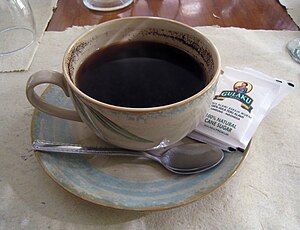
The most common and popular Indonesian drinks and beverages are teh (tea) and kopi (coffee). Indonesian households commonly serve teh manis (sweet tea) or kopi tubruk to guests. Since the colonial era of Netherlands East Indies, plantations, especially in Java, were major producers of coffee, tea and sugar. Since then hot and sweet coffee and tea beverages have been enjoyed by Indonesians. Jasmine tea is the most popular tea variety drunk in Indonesia, however recent health awareness promotions have made green tea a popular choice. Usually coffee and tea are served hot, but cold iced sweet tea is also frequently drunk. Kopi luwak is Indonesian exotic and expensive coffee beverage made from the beans of coffee berries which have been eaten by the Asian palm civet (Paradoxurus hermaphroditus) and other related civets. Kopi susu (coffee with sweetened condensed milk) is an Indonesian version of Café au lait. Es kelapa muda or young coconut ice is fresh drink which is made from chilled young coconut water, coconut flesh and syrup. It is among favourite beverage in Indonesia.
Fruit juices (jus) are very popular. Varieties include orange (jus jeruk), guava (jus jambu), mango (jus mangga), soursop (jus sirsak) and avocado (jus alpokat), the last of these being commonly served with condensed milk and chocolate syrup as a dessert-like treat. Durian can be made into ice cream called es durian.

Many popular drinks are based on ice (es) and can also be classified as desserts. Typical examples include young coconut (es kelapa muda), grass jelly (es cincau), cendol (es cendol or es dawet), avocado, jackfruit and coconut with shredded ice and condensed milk (es teler), mixed ice (es campur), kidney beans (es kacang merah), musk melon (es blewah), and seaweed (es rumput laut).
Hot sweet beverages can also be found, such as bajigur and bandrek which are particularly popular in West Java. Both are coconut milk or coconut sugar (gula jawa) based hot drinks, mixed with other spices. Sekoteng, a ginger based hot drink which includes peanuts, diced bread, and pacar cina, can be found in Jakarta and West Java. Wedang jahe (hot ginger drink) and wedang ronde (a hot drink with sweet potato balls) are particularly popular in Yogyakarta, Central Java, and East Java.
Alcoholic beverages

As a Muslim-majority country, Indonesian Muslims share Islamic dietary laws that prohibit alcoholic beverages. Since ancient times, local alcoholic beverages were developed in the archipelago. According to a Chinese source, people of ancient Java drank wine made from palm sap called tuak (palm wine). Today tuak continues to be popular in the Batak region, North Sumatra. A traditional Batak bar serving tuak is called lapo tuak. In Solo, Central Java, ciu (a local adaptation of Chinese wine) is known. Bottled brem bali (Balinese rice wine) is popular in Bali. In Nusa Tenggara and Maluku Islands the people also drink palm wine, locally known as sopi. In the Minahasa region of North Sulawesi, the people drink a highly alcoholic drink called Cap Tikus. Indonesians developed local brands of beer, such as Bintang Beer and Anker Beer.
Eating establishment
In Indonesia, dishes are served from a fine dining restaurant in five-star hotel, a simple restaurant downtown, humble street side warung under the tent, to street hawker peddling their gerobak (cart) or pikulan (carrying using rod).
Restaurant and warung

In Indonesia rumah makan means restaurant, while warung means small and humble shop. From these eating establishments, a warteg (warung Tegal) and rumah makan Padang are particularly notable for their ubiquitousness in Indonesian cities and towns.
A warteg or warung tegal is a more specific warung nasi, established by Javanese people from the town Tegal in Central Java. They sells favourite Javanese dishes and rice, the wide array of pre-cooked dishes are arranged in glass windowed cupboard. They are well known on selling modestly-priced meals, popular among working class such as low-skilled labours in the cities. While rumah makan Padang is a Padang restaurant, a smaller scale Padang eateries might be called warung Padang.
Most of Indonesian restaurants are based upon specific regional cuisine tradition. For example, rumah makan Padang are definitely Minangkabau cuisine. Sundanese saung restaurant or colloquially called as kuring restaurants are selling Sundanese dishes. This includes Bataks' lapo, Manado and Balinese restaurants. While other restaurants might specifically featuring their best specific dishes, for example Ayam goreng Mbok Berek, Bakmi Gajah Mada, Satay Senayan, Rawon Setan Surabaya, Pempek Pak Raden, etc.
Street food

Indonesian street food are usually cheap, offer a great variety of food of different tastes, and can be found on every corner of the city. Street and street-side vendors are common, in addition to hawkers peddling their goods on bicycles or carts. These carts are known as pedagang kaki lima. These food hawkers on carts or bicycles might be travelling on streets, approaching potential buyers through residential areas whilst announcing their presence, or stationing themselves on a packed and busy street side, setting simple seating under a small tent and waiting for customers. Many of these have their own distinctive call, tune, or noise to announce their presence. For example, bakso sellers will hit the side of a soup bowl using a spoon, whereas nasi goreng sellers announce themselves by hitting their wok.

In most cities, it is common to see Chinese dishes such as bakpao (steamed buns with sweet and savoury fillings), bakmie (noodles), and bakso (meatballs) sold by street vendors and restaurants, often adapted to become Indonesian-Chinese cuisine. One common adaptation is that pork is rarely used since the majority of Indonesians are Muslims. Other popular Indonesian street food and snacks are siomay and batagor (abbreviated from bakso tahu goreng), pempek (deep fried fish cake), bubur ayam (chicken congee), bubur kacang hijau (mung beans porridge), satay, nasi goreng (English: fried rice), soto mie (soto noodle), mie ayam (chicken noodle) and mie goreng (fried noodle), taoge goreng (mung bean sprouts and noodle salad), asinan (preserved vegetables or fruits salad), laksa, kerak telor (spicy omelette), gorengan (Indonesian assorted fritters) and bakwan (fried dish of beansprouts and batter).
Indonesian street snacks include iced and sweet beverages, such as es cendol or es dawet, es teler, es cincau, es doger, es campur, es potong, and es puter. Indonesian cakes and cookies are often called jajanan pasar (market munchies).
Snacks
Kue

Indonesia has a rich collection of snacks called kue (cakes and pastry), both savoury and sweet. Traditional kue usually made from rice flour, coconut milk, coconut sugar and mostly steamed or fried instead of baked. Traditional kue are popularly known as kue basah ("wet kue") that has a moist and soft texture because of rich coconut milk. The kue kering (dried kue) is local name for cookies.
Indonesia has rich variations of kue, both native-origin or foreign-influenced. Popular ones include Bika Ambon, kue pisang, kue cubit, klepon, onde-onde, nagasari, kue pandan, lupis, lemang, lemper, lontong, tahu isi, getuk, risoles, pastel, lumpia, bakpia, lapis legit, soes, poffertjes and bolu kukus.
Traditional crackers
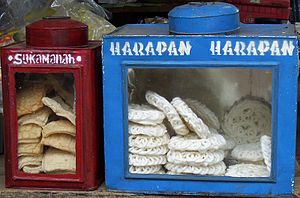
Traditional crackers are called krupuk, made from bits of shrimp, fish, vegetables or nuts, which are usually consumed as a crunchy snack or to accompany main meals. These crispy snacks sometimes are added upon the main meal to provide crunchy texture; several Indonesian dishes such as gado-gado, karedok, ketoprak, lontong sayur, nasi uduk, asinan and bubur ayam are known to require specific type of krupuk as toppings. There are wide variations of krupuk available across Indonesia. The most popular ones would be krupuk udang (prawn crackers) and krupuk kampung or krupuk putih (cassava crackers).
Other popular types include krupuk kulit (dried buffalo-skin crackers), emping melinjo (gnetum gnemon crackers), and kripik (chips or crisps), such as kripik pisang (banana chips) and keripik singkong (Cassava chips), rempeyek, is a flour-based cracker with brittle of peanuts, anchovies or shrimp bound by crispy flour cracker, rengginang or intip (Javanese) is rice cracker made from sun-dried and deep fried leftover rice.
Fruits


Indonesian markets abound with many types of tropical fruit. These are an important part of the Indonesian diet, either eaten freshly, or made into juices (such as jus alpukat), desserts (such as es buah and es teler), processed in savoury and spicy dishes like rujak, fried like pisang goreng (fried banana), cooked into cakes (such as kue pisang or bika ambon), sweetened and preserved such as sale pisang and manisan buah, or processed into kripik (crispy chips) as snacks like jackfruit or banana chips.
Many of these tropical fruits such as mangga (mango), manggis (mangosteen), rambutan, cempedak, nangka (jackfruit), durian, jambu air, duku (langsat), jeruk bali (pomelo), belimbing (carambola), kedondong and pisang (banana), are indigenous to Indonesian archipelago; while others have been imported from other tropical countries, although the origin of many of these fruits might be disputed. Klengkeng (longan) were introduced from India, semangka (watermelon) from Africa, kesemek from China, while alpukat (avocado), sawo, markisa (passionfruit), sirsak (soursop), nanas (pineapple), jambu biji (guava) and pepaya (papaya) were introduced from the Americas. Many of these tropical fruits are seasonally available, according to each species flowering and fruiting seasons. While certain fruits such as banana, watermelon, pineapple and papaya are available all year round.
Today, Indonesian markets is also enrichen with selections of home-grown non-tropical fruits that is not native to Indonesia. Strawberry, melon, apple, pear and dragonfruit are introduced and grown in cooler Indonesian highlands such as Malang in mountainous East Java, Puncak and Lembang near Bandung, to mimic their native subtropics habitat.
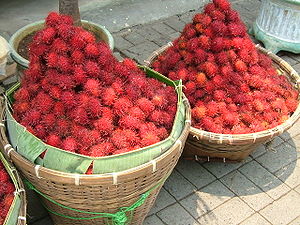
In the last few years, fruit chips have been more and more various. In the old times, banana and jackfruit chips were the most common, but now Indonesian fruit chips are also made from strawberry, apple, dragonfruit, pepino, watermelon, melon, more. Malang, a city in East Java, is the centre of fruit chip production aside from tempeh chips.
Banana and coconut are particularly important, not only to Indonesian cuisine, but also in other uses, such as timber, bedding, roofing, oil, plates and packaging. Banana leaf and janur (young coconut leaf) are particularly important for packaging and cooking process, employed to make pepes, lontong and ketupat.
Health
Nutrition

Much carbohydrate intake in Indonesian cuisine comes from rice, while in eastern parts of Indonesia, yam and sago are common. Indonesian protein intake comes from soy bean products that are processed into tofu and tempeh. Chicken eggs, poultry and meats are also consumed. Most of the fat intake comes from cooking oil (coconut oil) of fried dishes, coconut milk, peanuts, as well as meats and offals.
Some Indonesian fruit and vegetable dishes such as fruit rujak, gado-gado, karedok, pecel, lalab, capcay, tofu and tempeh are foods with low fat and high fibre. Tempeh, for example, is a vegetarian substitute for meat. Some dishes, especially gorengan (deep-fried fritters) and those dishes infused or caramelised with coconut milk, such as rendang and gulai, might taste succulent but are rich in saturated fat.
食の安全性
伝統的なインドネシアの家庭料理は、加工品、缶詰、保存食品をほとんど、あるいは全く使わずに毎日作りたてが食べられる。これは、保存料やナトリウムの量が最小限に抑えられていることを意味する。ほとんどの食材は早朝に地元の伝統的な市場で新鮮なものが購入され、午前中に調理されて主に昼食として消費される。残った料理は、食器棚やテーブルの上に「トゥドゥン・サジ」(虫や他の動物から食品を守るために編まれた竹製のフードカバー)で覆われ、すべて室温で保管され、夕食時に温め直して再び食べられる。 伝統的に、インドネシア料理は長期間保存されることはほとんどなく、ほとんどの料理はその日のうちに調理され消費される。乾燥食品、塩漬け食品、加工食品には一部例外がある。例えば、乾燥したルンダンは数日間は安全に食べられる場合がある。現代の冷蔵技術はほとんどの家庭で利用できる。
衛生
インドネシアの食料品や中級から高級な飲食店で提供される食品のほとんどは、Badan Pengawasan Obat dan Makanan(インドネシア食品医薬品監督庁)によって規制・監督されており、良好から許容範囲の食品衛生基準を維持しているが、一部のワルン(伝統的な屋台)や露天商では衛生状態が悪い場合がある。また、熱帯の微生物は、特にインドネシア滞在中の外国人において、主に胃腸炎などの食中毒の事例を引き起こす可能性がある。そのため、ボトル入りの飲料水や沸騰させた飲料水を飲むか、露天商で売られている未調理の常温食品ではなく、加熱調理された温かい食品を選ぶことが賢明である。
関連項目
Bibliography
- オーウェン, スリ. "Indonesian Food and Cookery" ISBN 978-0907325000, Prospect Books, 1980.
- オーウェン, スリ. "Sri Owen's Indonesian Food" ISBN 978-1910496718, Pavilion Books, 2015.
- ウォンソ, ウィリアム. "Flavors of Indonesia: William Wongso's Culinary Wonders", ISBN 978-9798926327 Bab Publishing, 2016.
- フォード, エレノア. "Fire Islands: Recipes from Indonesia", ISBN 978-1911632047 Murdoch Books, 2019.
外部リンク
| この記事は、クリエイティブ・コモンズ・表示・継承ライセンス3.0のもとで公表されたウィキペディアの項目Indonesian cuisine(13 June 2025, at 11:06編集記事参照)を翻訳して二次利用しています。 |










